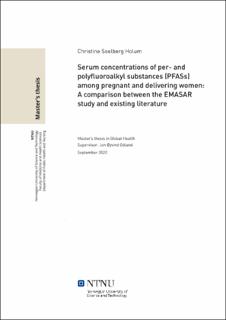| dc.description.abstract | Background: Per- and polyfluoroalkyl substances (PFASs) is found ubiquitous in the environment and humans worldwide. These chemicals are proved to be toxic, persistent and has the capacity for long-range travels. PFASs are recognized as being responsible for adverse health effects in humans, especially fetuses and newborns in rapid development due to placental and lactational transfer.
Design and methods: This thesis is a descriptive part of the Estudio del Medio Ambiente y la Salud Reproductiva (EMASAR) study, with the aim to explore the PFASs concentrations in maternal serum. A study on environmental and reproductive health in two different regions in Argentina, Ushuaia (n = 193) and Salta (n = 496). Sampling of maternal serum, personal- and sociodemographic characteristics found place between 2011-2012. The PFASs levels from the EMASAR study is compared to delivering and pregnant women from other countries in different regions of the world.
Results: Salta’s socioeconomic status as underdeveloped and fragmented and Ushuaia’s status as the most prosperous in the country is reflected in the results, the women from Salta were younger, had on average more children and were less educated compared to the women in Ushuaia. Perfluorooctane sulfonate (PFOS) were the PFAS with highest concentration levels in delivering women both in Ushuaia and Salta (0.84 and 0.7 ng/mL, respectively), followed by pentafluorobenzoic acid (PFBA). The correlation between several of the PFASs were moderate to strong, with the strongest correlation between the PFASs in the two different regions were, rs = 0.648 (p = 0.05) for PFOA and PFNA in Ushuaia and rs = 0.656 (p = 0.05) between PFOA and PFHxA in Salta.
Conclusion: Among the PFASs concentrations from delivering women in Ushuaia and Salta, PFOS was the most prominent substance, followed by PFBA and PFOA, with a slight elevated level in Ushuaia compared to Salta. Compared to other regions of the world, the levels from the two study sites are low, but even relatively low levels of exposure to PFASs may have adverse effects on fetus and child health. Several of the PFASs correlates moderately to strong with each other. | |
